 I used to dream about what i’d do if I suddenly didn’t have to do everything-else-I-have-to-do. When our lives were a constant dull hum of the front door slamming and car keys clanging as I whipped in and out of the house taking kids here, rushing to catch a train, running out to the longarm to squeeze in some work before school pick up, rushing on the edge of late to meet friends for coffee or dinner. Then we locked down and all of that came to a screaming stop.
I used to dream about what i’d do if I suddenly didn’t have to do everything-else-I-have-to-do. When our lives were a constant dull hum of the front door slamming and car keys clanging as I whipped in and out of the house taking kids here, rushing to catch a train, running out to the longarm to squeeze in some work before school pick up, rushing on the edge of late to meet friends for coffee or dinner. Then we locked down and all of that came to a screaming stop.
They’re calling the Covid crisis ‘The Great Pause’ in the newspapers, which makes me raise my eyebrows just a touch as a working mum with 3 ‘jobs’, 3 kids and a work from home husband suddenly here all day, pausing isn’t really happening a lot, yet the idea of stepping outside of our usual routines inevitably creates at least new pockets of time. The biggest gain for me is in headspace. My usual portmanteau career of writing for magazines, post grad study, commercial long arm quilting and charity board work alongside 3 kids and all the scheduling that goes with 3 teen/ tweens means that before now my head was usually running a low background hum of ‘remember this, submit that paper, pick up that, email them, wash this and remember to defrost that’.
This new normal means that most of that is suddenly simplified or just compartmentalised into specific times of the day rather than segmented by the constant in-and-out-the-front-door of rushing family lives. The gain to me has been space to think, to dream a little and to really consider my making.
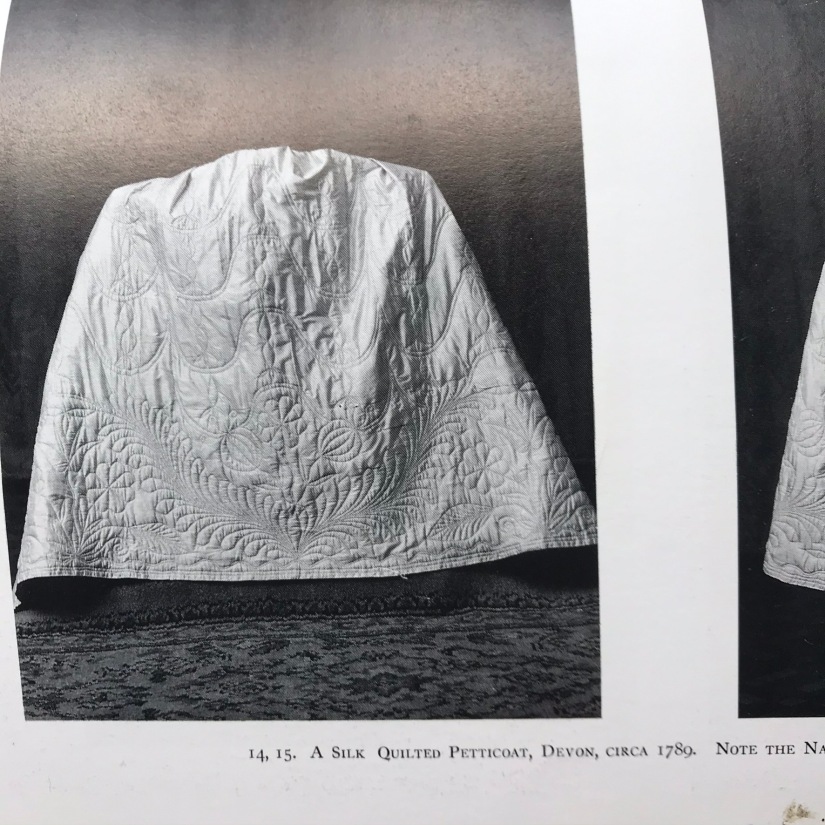
As a student quilt historian I’ve always been fascinated by those items on the edges of the story of quilting, that are both luxurious and workaday – the quilted garments. Museums often contain numerous examples of these, they are items that pop up as side interest in fashion and costuming displays, but in the specifically quilting world they are inexplicably often overlooked in favour of their more practical bedquilt sisters. (however do check out the Quilters’ Guild exhibition of quilted clothing that took place, details on the website www.quiltmuseum website.
I wonder why? Contemporary quilted clothing definitely suffered from an image problem for many years with memories of many a dubious quilted waistcoat spotted at the early quilting shows I attended 20 years ago, yet now every year there seems to be a catwalk story of a designer incorporating some element of patchwork or quilting on the runway as fashion turns away from fast fashion and back to couture techniques and hand sewn craft traditions to justify their price and exclusivity. Modern quilted clothing has been helped by the same forces that have exploded craft beer and spoon whittlers and all the tenets of hipster culture in our cities, and there are wonderful designers making quilted jackets (either incorporating old quilted items taken from quilts and coverlets or making new panels to use in their pattern cutting) that are covetable from Shoreditch via Berlin and Cape Town to Brooklyn.
Yet historical fashion is rich with quilted items of such sumptuousness and obvious fashion flair and yet they get very little focus in mainstream quilting discussion. Part of this I think may be that quilting as a technique is less well known and practised amongst costume enthusiasts, who have jaw dropping dressmaking skills, but often resort to ready quilted fabrics for petticoat recreations, and similarly quilt makers are busy making quilts? They kind of fall in the largely unpopulated middle of two distinct Venn diagrams of interest.
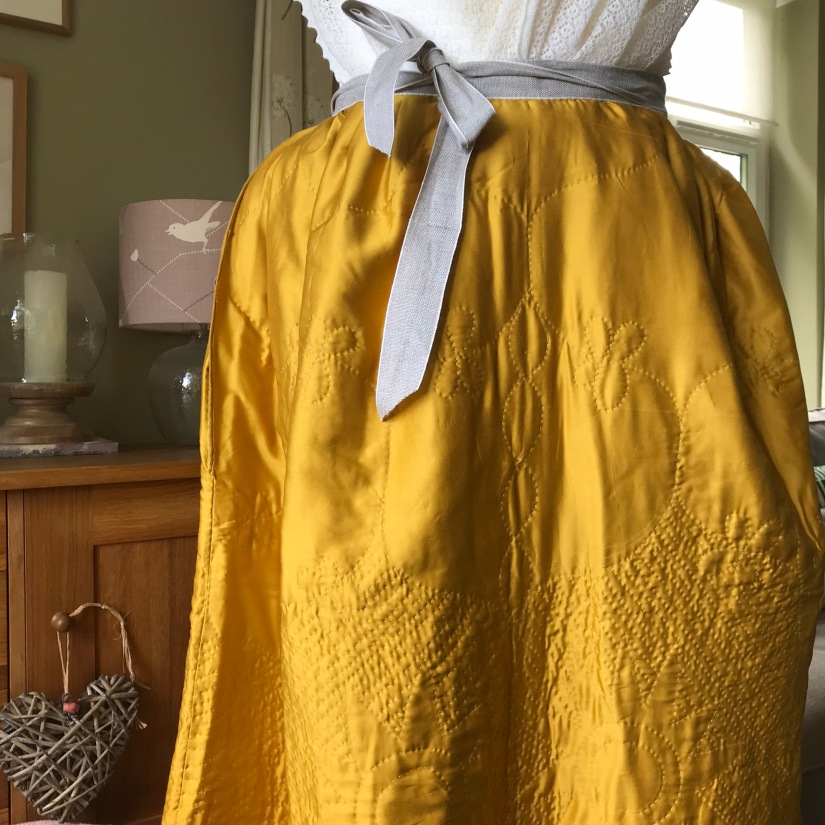
My nascent fascination with this area has been a long slow burn. Firstly the appeal of wearing a quilt is clear if you live in the damp climes of the UK in a Victorian house with drafty floorboards, I’ve often joked about quilting my clothes. Secondly, I’ve found myself turning increasingly away from ‘quilting’ cottons and experimenting with other fabrics, often reusing vintage textiles, or revelling in the tactile nature of textiles like linen as quilting base cloths. Silk was just a small step further along that road, no? Lastly, the draw was colour! When you think of clothing of the past it’s a usual cliche to imagine a much duller palette, NO! If you had the funds for fabulous fabric you were going to show it off and my favourite historical show off colour is this fabulous mustard or ‘egg yolk’ yellow – a real fashionable favourite in the mid 1700’s period when quilted petticoats were so in vogue. All of this collided in a storm of Covid-created anxiety this spring, but out of those black clouds has blossomed a beautiful glowing project, and for that I am grateful.
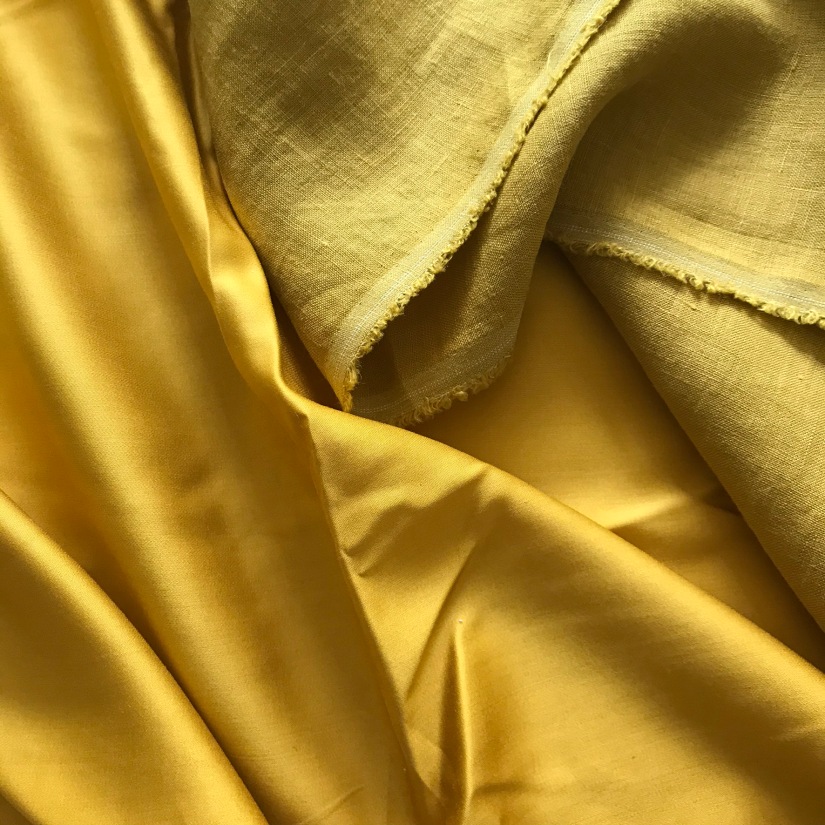
Like everyone, the necessities of just getting through those first weeks of lockdown were overwhelming. Yet in amongst the grey fear and worry, I needed a creative escape and dreaming, researching and planning this project was it.
The quilted petticoat was a staple clothing item for many years, it’s zenith however was the mid to late 1700’s amongst the splendour and heady rush of enlightenment thinking and Georgian style. Their petticoats were made of silk, beautifully hand quilted and fashions adapted to show them off as gowns became open fronted, or lifted behind in ruffles ( a la Polonaise) or with a short jacket (Caraco) and were widely worn in varying forms at all levels of society and we know this because they immortalised these petticoats in numerous portraits and paintings of the era.

The designs on petticoats are a fascination for the wholecloth quilt designer, both familiar and exotic in comparison to their flat quilted cousins. The wealth of ideas to draw from was huge and there was a whole new ‘vocabulary’ of design to accomodate designs into a three dimensional shape. I settled on sunflowers for this sunny silk and incorporated motifs from several sources to create a new pattern.
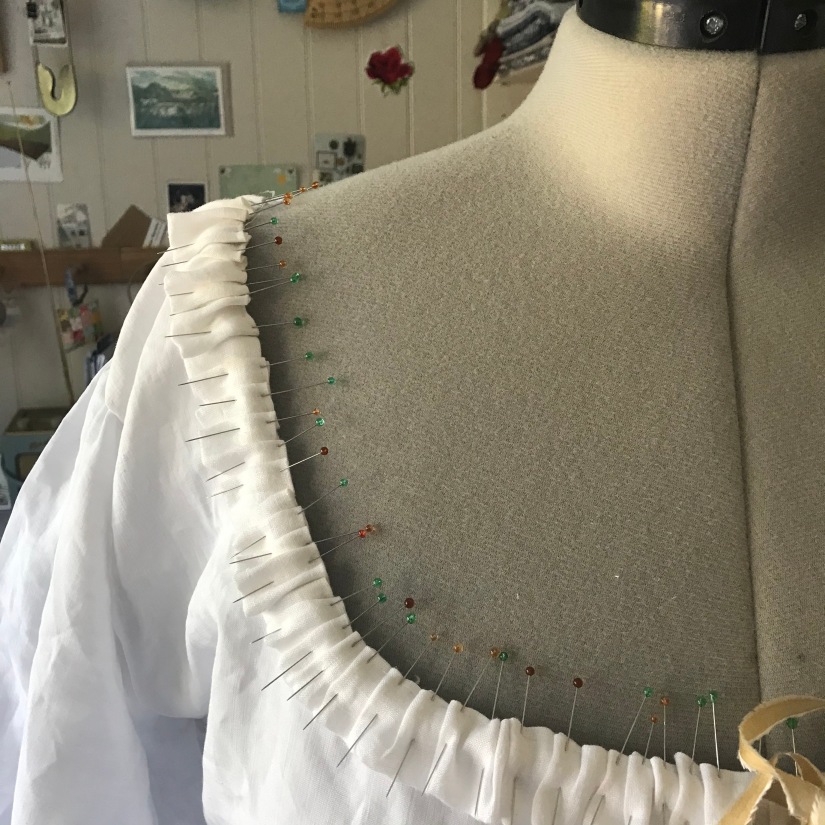
Like all the best projects, left to marinade in the rich sauce of extra free time and subjected to the invention of necessity in a world where shops aren’t open, this project of course blossomed into a much bigger undertaking! If I were to have a petticoat it needed a shift to wear underneath, if a shift then why not an under petticoat? Luckily I had recently acquired a stash of vintage linen flat sheets that I had planned to use for quilting, but they formed a historically perfect, budget fabric resource for all manner of 18th century sewing projects. Like all sewists I have an under utilised stash of trimmings that I was delighted to bust into for this project.

Clothes were sewn by hand in this era, so the patterns reflect that, shifts made from simple basic rectangles, any offcuts of fabric from the shaping repurposed to make gussets under the arms for greater movement. The sheer simplicity and plainness of the sewing was a huge tonic in these garden-sewing days. The long hand sewn seams then rewarded with the giddy fun of trimming.

The fabric I settled on for my petticoat was a Bamboo Silk, sumptuous and beautiful ( and a little eye watering ££) so marking on it was always going to be a worry. I’m a slapdash marker but this had to go well and I ended up using chalk which does tend to wear off the slippery silk but as long as I kept remarking we seemed to get by ( I bought the fabric at Raystitch and the chalk pen from Pincushion Pantiles ).

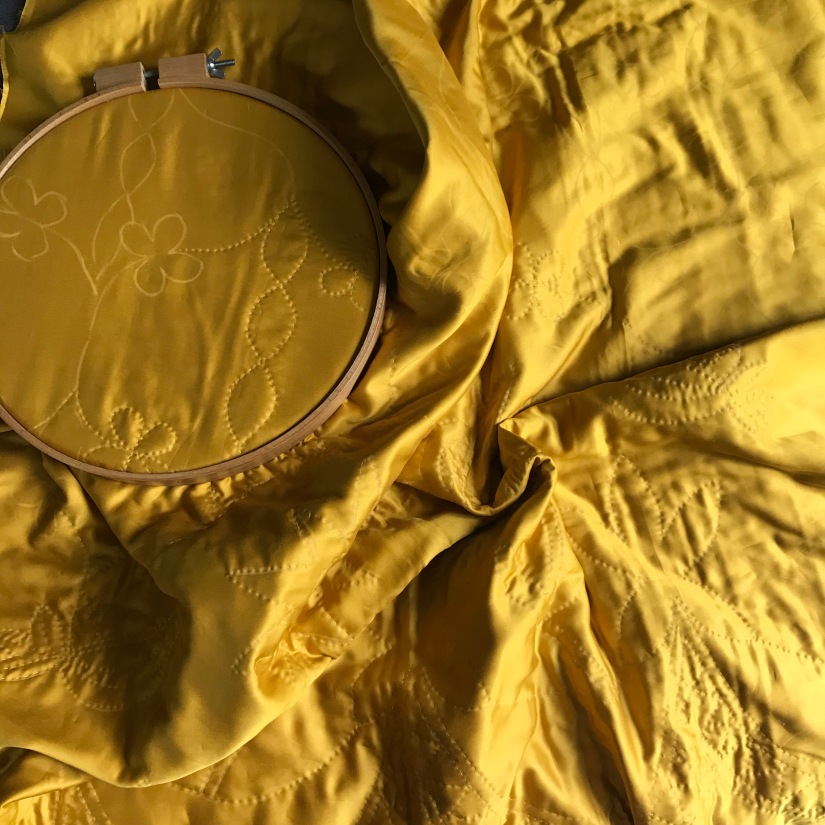
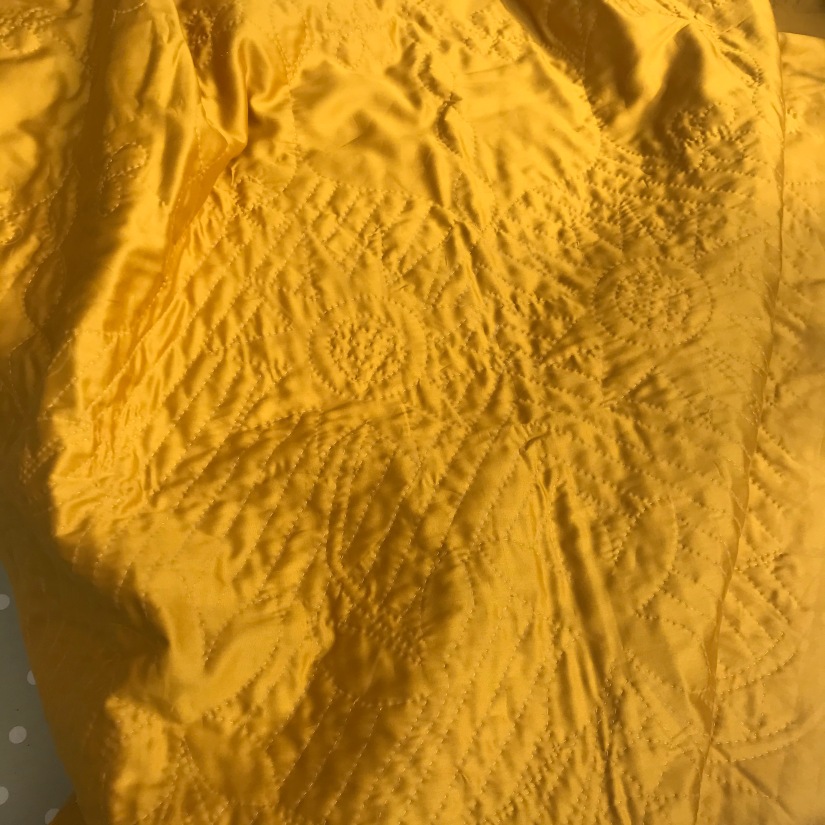
Those following on Instagram will know that I am also working on a range of ‘accessories’ from the period that also included quilting techniques, tie on pockets, a stomacher, fischu and other bits and pieces as the mood takes me. I’ll do a Part 2 when the whole project is complete – remember everything i’ve made so far is essentially underclothes ( even though the petticoat will be seen), I still need to settle on a plan for the outer garments which is a whole other making project that will probably see this project continue on throughout this strange year.

The events of this year (2020) came as a huge shock and change to all of our lives, bringing tragedy and worry to many. Whilst it pays to be careful what we wish for (more time at home? More time with our family? A slower pace of life?), it’s also true that we should make sparkling lemonade when we have only lemons to hand. This lemon bright effervescent frosting of a sewing project has been just that for me. An attempt to use and channel the place we all found ourselves in, in a way that sees something positive come from it. Finding a project that both grew my historical quilting knowledge, as well as challenging my technical skills was a real welcome distraction and a beguiling silken escape from the realities of our lockdown worlds. I’ll always be grateful for it, even if I will have to stop wearing it all the time to go back to dressing for today’s world again when lockdown is finally completely over!!!
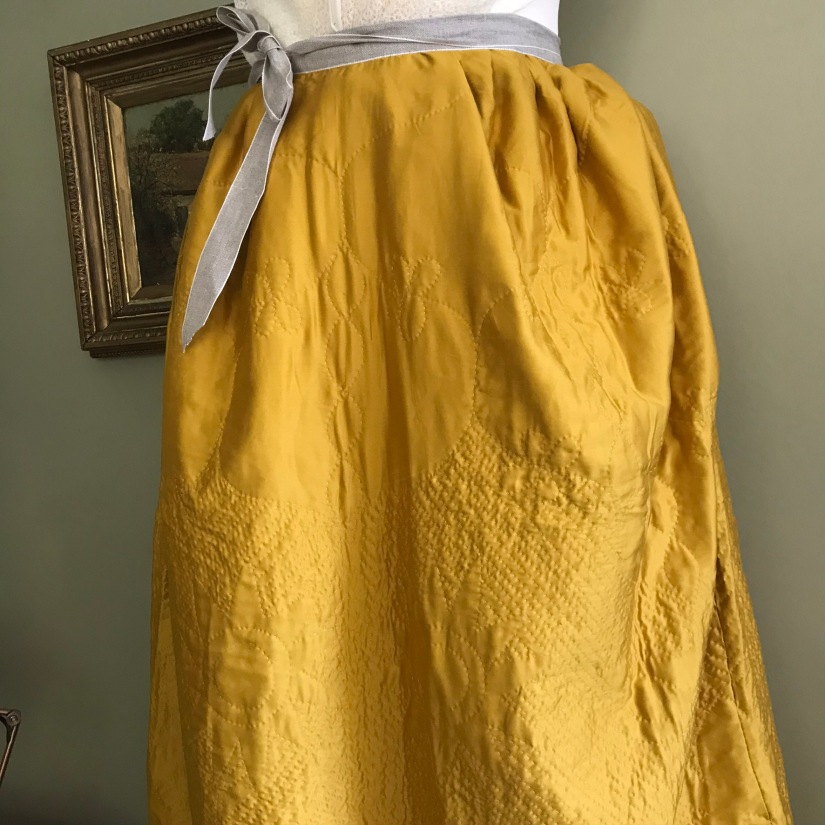









8 thoughts on “The Georgian Quilted Petticoat Project”